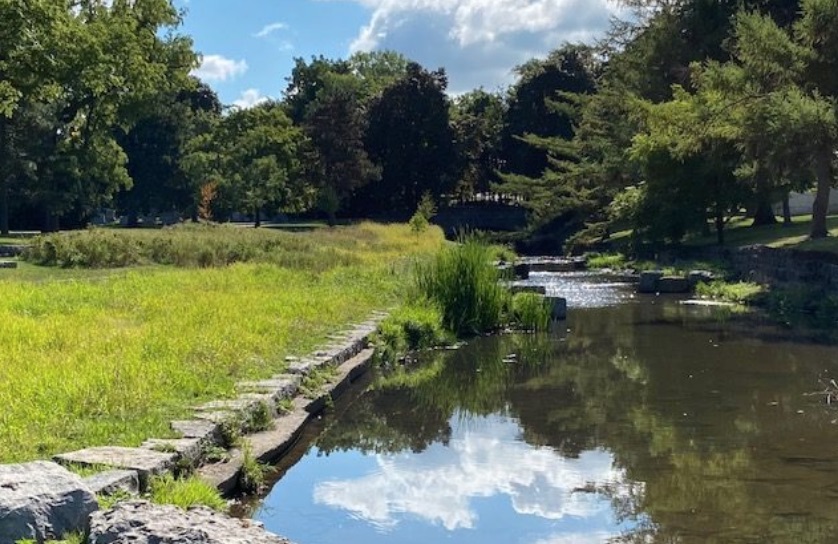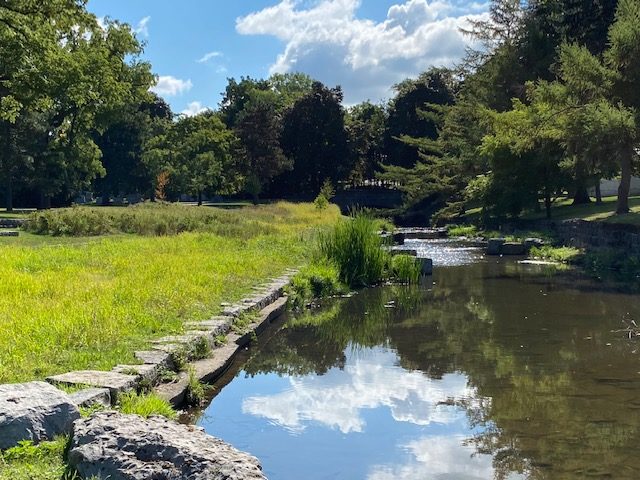
AUTHOR: JILL JEDLICKA, BUFFALO NIAGARA WATERKEEPER EXECUTIVE DIRECTOR
This is the first in a four-part, guest author series, highlighting what is possible through the vision of a restored Scajaquada Creek corridor. This series shared over the next two weeks, will place a priority focus on a community-inspired vision for Scajaquada’s waterway, park system, trail and transportation networks, and community revitalization.
Defining moments don’t come around very often – but here we are. The year 2021 will provide the last, best chance in a generation to reclaim our creek and community. Why the urgency? Many decisions are on the horizon for infrastructure priorities in our region, particularly in the Scajaquada Creek corridor and closely related to the 198 redesign effort. We can either seize the opportunity now, or get left behind.
For years, many non-profits, advocates, and community voices have been standing shoulder to shoulder in the Scajaquada Creek corridor with the collective goal of restoring this waterway, improving the transportation and trail networks, and better connecting surrounding communities to each other, their parks and conservation areas.
This dedicated group of organizations and individuals has come together to develop and coalesce around a community-inspired vision of what is possible for this creek corridor.
As part of an upcoming public outreach around the future status of the Scajaquada Expressway (Route 198), the public at large will be asked to engage in that planning process. This four-part guest-author series is intended to share components of a community-inspired vision, not portraying it as the final solution, but as an ambitious starting point for critical infrastructure conversations to come.
Restoration of the Historic Scajaquada Creek
Stretching 13 miles from it headwaters in Lancaster, through Depew, Cheektowaga and into the City of Buffalo, Scajaquada Creek is one of the most polluted and impaired waterways in New York State. This unfortunate distinction is due solely to decades and decades of bad decisions. Our region has chosen to create and accept living alongside a creek that is polluted, buried, channelized, hardened, industrialized, and mangled by road infrastructure, supporting minimal vegetation and wildlife, and being choked with raw sewage every time it rains.
It doesn’t have to be this way.

Patchwork efforts are inefficient and take a long time. In 2021, we can choose a deliberate and direct path towards a restored creek corridor by envisioning a redesign that starts with the needs of the creek and our communities first. The vision reclaims significant portions of the historical natural course of the waterway and its floodplain. It embraces the social and cultural history the creek envelopes. It reclaims ecological functions, flood protection, and provides access to neighborhoods that have been cut off from the waterway for generations. And finally, a deliberately restored creek corridor will provide a foundation for economic growth, smart transportation infrastructure, and prosperity for the next generation.

Scajaquada Creek may be a small waterbody at only 13 miles in length, but it is a giant when it comes to its impact on our region. For several hundred years it has weaved through our diverse communities, connecting cultural, social and natural assets – it’s only been since the 1950’s that we accelerated the burial, division and abuse of the creek beyond recognition.
Scajaquada Creek can soon become another one of the best success stories for waterway restoration in our region, New York State, and the nation. Sound too far-fetched? Consider this—our community has done it once already. The restoration and economic revitalization of the Buffalo River corridor has become an international success story.
Buffalo Niagara Waterkeeper has won international awards for having the audacity to reclaim and restore a polluted waterway, but more importantly for creating the unique partnerships that enabled it all to happen. The Buffalo River corridor has seen approximately $400 million in investment since the community rallied to declare that the river was going to be restored.
It happened. It’s real. It can happen for Scajaquada Creek, too, if we commit to innovative collaboration to make the vision a reality.
Rethinking the Scajaquada Expressway corridor is not simply a debate about no road, little road, big road, or gigantic road. It’s a $100 million or more investment into our local economy and quality of life. Why not get the most out of every last penny from that investment, to serve a higher purpose for the entire community? We should leverage every dollar by layering in other sources of public, private, non-profit and philanthropic investment – all delivering to the same bold vision that looks at way more than just moving vehicles from one point to another.
From Buffalo Niagara Waterkeeper’s view, the potential for finally restoring the health of the Scajaquada Creek ecosystem is enormous. The creek corridor redesign effort can be integrated into sewer improvement projects along its entire stretch that will significantly reduce the volume of raw sewage that ends up in the creek. The redesign effort can incorporate green infrastructure and neighborhood beautification techniques that filter stormwater runoff from carrying pollutants from land into the creek. The redesign effort can allow for park restoration, waterfront access and development, restoration of critical segments of the historical path of the waterway, reclamation of the floodplain, and enhancement of the ecological health and function for fish and wildlife.
In nature, life thrives where water meets the land, and the same goes for the human species. This redesign effort can finally restore connections to the creek with communities that have been cut off from this waterway for generations.
A community inspired vision, called Scajaquada Reimagined, will soon be released, and through this vision we can ensure the living infrastructure of Scajaquada Creek corridor is prioritized and accurately reflects the voices of people who should benefit from a once in a generation opportunity.
This vision is not fantasy, it is achievable – cities all over the world make things like this happen. We can have clean creeks and sustainable communities, too, but only if the public supports this kind of vision and demands these kinds of outcomes from infrastructure planning efforts, such as the upcoming Scajaquada Expressway redesign process.
Please join us in the public conversations to come.
Source: https://www.buffalorising.com/2021/03/reclaiming-the-scajaquada-creek-corridor-part-1-of-4/



